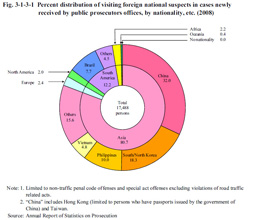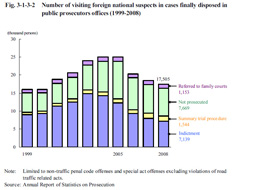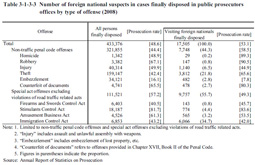| Previous Next Index Image Index Year Selection | |
|
|
1 Disposition in public prosecutors offices (1) Received casesFig. 3-1-3-1 shows the percent distribution of visiting foreign national suspects in cases (limited to non-traffic penal code offenses and special act offenses excluding violations of road traffic related acts; hereinafter the same in this section) newly received by public prosecutors offices by nationality, etc. in 2008. By region of origin, Asia accounted for 80.7%. By nationality, etc., those from China (including Hong Kong and Taiwan; hereinafter the same in Subsections 3 and 4) was the most common at 32.0%, followed by North/South Korea at 18.3%, the Philippines at 10.0%, Brazil at 7.7%, and Vietnam at 4.8%. Fig. 3-1-3-1 Percent distribution of visiting foreign national suspects in cases newly received by public prosecutors offices, by nationality, etc. (2008) (2) Disposed casesFig. 3-1-3-2 shows the number of visiting foreign national suspects in cases finally disposed by public prosecutors over the last 10 years. The number continued decreasing every year from 2005 and was 17,505 (down 988 or 5.3% from the previous year) in 2008. The number of visiting foreign national suspects in cases finally disposed in 2008 accounted for 4.0% of total persons finally disposed by public prosecutors (433,376) and 79.7% of foreign national suspects in cases finally disposed (21,974). Fig. 3-1-3-2 Number of visiting foreign national suspects in cases finally disposed in ublic prosecutors offices (1999–2008) Table 3-1-3-3 shows the number of visiting foreign national suspects in cases finally disposed in public prosecutors offices in 2008 by type of offense.Theft was the most common among non-traffic penal code offenses, followed by injury (including assault and unlawful assembly with weapons), embezzlement (including embezzlement of lost property, etc.), and counterfeit of documents (including all the offenses stipulated in Chapter XVII, Part II of the Penal Code). Comparing the prosecution rate of visiting foreign national suspects with that of all persons finally disposed by public prosecutors revealed that the prosecution rate of visiting foreign national suspects for non-traffic penal code offenses was 14.1 points higher. And although the prosecution rate for special act offenses was 7.8 points lower, that excluding Immigration Control Act violations was 3.5 points higher. Table 3-1-3-3 Number of foreign national suspects in cases finally disposed in public prosecutors offices by type of offense (2008) |


